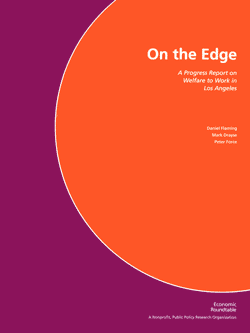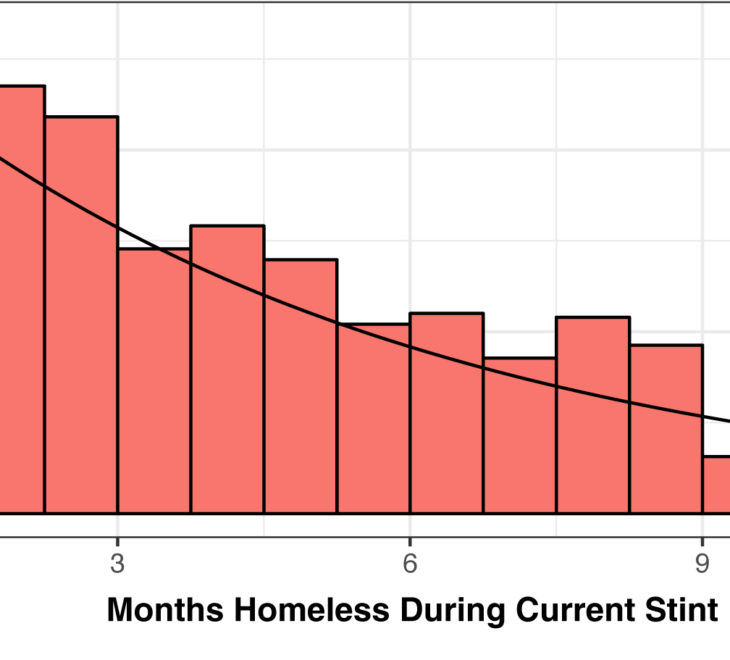 The loss of a welfare safety net for most adults for most of their lives makes the quality of jobs available to the working poor and their success in finding and keeping jobs increasingly important. The economic and civic life of the Los Angeles region will be shaped by connections that are made, or fail to be made, between the growing ranks of working poor and opportunities for steady, sustaining, productive employment.
The loss of a welfare safety net for most adults for most of their lives makes the quality of jobs available to the working poor and their success in finding and keeping jobs increasingly important. The economic and civic life of the Los Angeles region will be shaped by connections that are made, or fail to be made, between the growing ranks of working poor and opportunities for steady, sustaining, productive employment.
The release of this report coincides with the first anniversary of the federally mandated welfare-to-work program in Los Angeles County, which has more residents below the poverty level than any other county in the nation and all but four states. The ability of working-poor families to find jobs that lift them above poverty will shape the future ability of this region to maintain clean parks and public spaces, improve infrastructure, provide essential public services such as health and education, raise a new generation of children who succeed in school and become productive adults, and preserve a civic life that is not increasingly polarized between those in comfort and those in poverty.
Background of Research
This study was undertaken at the request of the Los Angeles County Board of Supervisors to provide information about the actual employment outcomes of welfare recipients who were reported to have found jobs. On February 10, 1998, the Board of Supervisors approved a motion requesting the Economic Roundtable to prepare an analysis of long-term earnings of GAIN job seekers. GAIN (Greater Avenues for Independence) is the county’s welfare-to-work program.
Following this request, the county’s Department of Public Social Services released 99,469 records representing all of the aid recipients who participated in GAIN from 1990 through 1997 and were reported to have found work. Confidential earnings information was obtained from the Employment Development Department’s Base Wage file, showing quarterly earnings of each welfare worker from the beginning of 1990 through the first quarter of 1998. This population of welfare workers found jobs with 101,462 employers.
Welfare workers whose characteristics and earnings are analyzed in this report are individuals who participated in GAIN and were reported by program staff to have found jobs. They do not represent all of the participants in Los Angeles County’s GAIN program (about half of whom did not find jobs) or the general population of families with children receiving welfare, many of whom were not referred into GAIN. Recipients whose outcomes are analyzed in this report represent the most successful half of GAIN participants.
During the eight-year period covered by this data, GAIN went through three program phases: (1) a basic education program from 1990 to 1993, (2) a “work-first” model from 1993 to 1996 that focused on long-term welfare recipients and emphasized immediate job search activities rather than skill development, and (3) a continuation of work-first with an emphasis on new entrants to welfare from mid-1996 through 1997.
As a consequence of these shifts in program emphasis, the population of welfare workers represented in our data is representative of the total population of welfare recipients who are able to find employment without intensive program intervention. During the period covered by our data, approximately 15 percent of GAIN participants were volunteers, and 85 percent were non-volunteers, reflecting the mandatory job-seeking obligation that now applies to all aid recipients.
Now that most welfare recipients are by law part of the workforce, it is very important that we understand the footholds they are finding in our collective economic life. Most welfare recipients find jobs, and many of the working poor have difficult times when they must resort to welfare. The population we are studying straddles these two worlds.
Key Findings
- GAIN has significantly increased employment rates among participants.
- In 1997, 65 percent of long-term GAIN workers (those whose first GAIN job was at least three years earlier) had earnings below the poverty threshold for just one person and 74 percent had earnings below the poverty threshold for their families.
- Most GAIN workers have low-paying jobs in low-wage industries, and many of these industries are growing in Los Angeles County. There is a shortage of jobs in the county that pay sustaining wages to workers with average levels of education.
- Education and the ability to speak English are the most significant factors associated with GAIN workers who had higher earnings.
- Characteristics of GAIN workers, the kinds of jobs that are available to them, and the amount that they earn vary significantly from one city to another in the county.
Progress Report on Work and Earnings
Earnings records of nearly 100,000 welfare workers over eight years show that Los Angeles County’s welfare-to-work program (GAIN) has had a significant effect on employment rates among workers. Over the eight-year period of 1990 to 1997, the quarterly employment rate among GAIN workers was an average of 29 percentage points higher after they went through GAIN than before (56 percent versus 27 percent). This increased employment resulted in higher collective earnings.
The troubling finding is that after an initial jump, earnings tapered-off at a level that left 65 percent of long-term GAIN workers below the poverty threshold for one person, and 74 percent below the poverty threshold for their families in 1997. Average annual earnings of GAIN workers with jobs have declined from 26 percent of the average pay for a job in the Los Angeles labor market in 1990 to 24 percent in 1997.
Employment levels among two-parent households are slightly lower than among one-parent households. Thirty-six percent of two-parent households had no employment in 1997, and only 42 percent worked all four quarters of the year. This suggests that the county will have difficulty complying with the federal requirement that as many as 90 percent of these families have an adult family member participating in work or work-related activities.
Los Angeles County’s Department of Public Social Services (DPSS) has made notable progress in shifting from a mission of eligibility determination to one of family self-sufficiency, yet the findings in this report offer strong evidence that GAIN will need to move beyond the “work-first” model to continue its progress in helping welfare workers become economically self-sufficient. The motto and central premise of the GAIN program is “a job, a better job, a career.” Our findings show that this career progression has not occurred for most welfare workers. This finding does not diminish the credible achievement of GAIN in helping welfare recipients move into work, but it does provide new and important information about what remains to be accomplished.
In 1993, the work-first strategy was initiated in Los Angeles County following evaluations by the Manpower Demonstration Research Corporation (MDRC) that found this approach had been successful in Riverside County. However, the definition of “success” that led to a favorable evaluation of the work-first model was reduction in welfare payments. This is very different from the standard for success under welfare reform, which is achievement of long-term economic self-sufficiency by most recipients. The work-first model was judged successful because it had lower costs than training programs as the earnings of welfare job seekers led to reduction (or in a small percent of cases, discontinuance) of welfare benefits. But this report offers strong evidence that in the absence of human capital investments, work-first strategies result in a majority of recipients repeating previous experiences of sub-poverty, temporary employment without career mobility.
The importance of education and training is demonstrated by stronger outcomes achieved by individuals who have been routed into education and training activities by the GAIN program. Over the past eight years, 12 percent of GAIN participants have taken part in education or training programs. Those who received education or training entered GAIN with a history of lower earnings, but after GAIN had earnings 16 percent higher in the first year and 39 percent higher in the fifth year than those without education or training. Furthermore, participants in the first phase of GAIN that emphasized basic education have had significant long-term improvement in earnings. Among comparable participants, those who were enrolled in this first phase have the highest average earnings of any group served by GAIN.
Education is not by itself a silver bullet that eradicates poverty, but findings in this report indicate that it is the single most powerful factor affecting incomes of the working poor. It is also the most readily available and administratively feasible remedy for helping the working poor become economically self-sufficient.
Industries Employing Welfare Workers
Workers attempting to leave welfare are asserting a growing presence in a labor market that is increasingly polarized between high-wage professional, managerial, and technical jobs on the one hand, and low-wage production, retail, and service jobs on the other. Jobs in the middle providing good wages and benefits are shrinking.
Like all other workers, GAIN participants are subject to the job opportunities available from employers, and the quality of those opportunities is sensitive to labor market conditions. Increasing numbers of welfare workers have found jobs during this decade, but this population worked for diminishing amounts of pay until the end of 1995. The average earnings of GAIN workers declined together with total employment in the Los Angeles labor market from the onset of the 1990 recession through 1992. However, even after overall job loss slowed in 1993 and the economy entered a period of stagnation, earnings of welfare workers continued to decline for two more years.
The probable explanation for continued shrinkage in the paychecks of welfare workers after the labor market stabilized is reduction in the number of hours they worked. Earnings are a proxy for total number of hours worked per quarter, and during the recession many were probably reduced to part-time work. Because most are at the fringes of the labor market, the rising tide that lifted other ships appears to have taken longer to reach them.
When we look at changes in employment levels of GAIN workers on a quarter-to-quarter basis we see a close connection between earnings and changes in the total labor market. While changes in employment and earnings of GAIN workers are closely tied to trends in overall county employment levels, they have a degree of fluctuation that is more than five times greater than corresponding changes in the overall labor market. This is because most GAIN workers are part of a contingent labor force experiencing high rates of job turnover.
This finding suggests a strong relationship between the performance of the Los Angeles economy and its level of job creation and the amount of wages that adults who are receiving public assistance can obtain through employment. GAIN workers can be seen as a segment of the labor market that tends to work in less secure and lower-wage jobs, and who thus have frequent periods of unemployment and low earnings. There is probably much movement into and out of public assistance among this segment of the overall working population, with a significant number of these families experiencing chronic poverty. Their fortunes tend to rise and fall with the work experience of the total working population, but the class of workers represented by GAIN participants is simply more vulnerable in times of economic decline or stagnation.
Personnel supply service firms (temporary employment agencies are part of this group) are the largest employer of welfare workers, accounting for 13 percent of all jobs held by GAIN workers in 1997. This industry’s share of welfare employment has more than doubled since 1990. In 1997, the highest concentrations of GAIN workers were found in industries paying the lowest wages and as a corollary, industries with the lowest concentrations of GAIN workers paid the highest average wages.
Most GAIN job holders are low-wage workers in low-wage industries that offer few prospects for upward mobility. For these workers to become self-sufficient, most will need skills that will enable them to enter new industries. Strategies that enable GAIN workers to move into industries that pay sustaining wages will offer parallel benefits for the regional economy by supporting growth of industries that create more value per job. An important challenge is to design both worker training and job creation programs that support movement into, and growth of, industries that make greater contributions to the regional economy as well as to the workers they employ.
Economic growth resulting in 160,000 GAIN workers moving up the income ladder by one rung each (an average of $4,670 a year more in earnings per worker) would: increase their collective income and buying power by over $750 million a year, create over 20,000 jobs, add over $1.5 billion to the economy, and add over $40 million a year in local taxes paid by businesses.
Geography of Welfare Employment
Welfare workers are highly concentrated in the Inner City and San Gabriel Valley, with smaller concentrations in adjacent communities to the south and north. Relatively few welfare workers reside in the western parts of Los Angeles County. The problems of poverty in Los Angeles are not readily explained by a flight of jobs to the outer districts of Los Angeles County. Instead, the restructuring of jobs and labor supplies have contributed to the growth of insecure, low-wage employment throughout the Los Angeles region.
Analysis of Employment Outcomes
Differing levels of education and English language ability can account for most differences in earnings between ethnic, immigrant and age groups. For example, older workers with the same level of education earn more than younger workers, but relatively few older GAIN workers have as much education as younger GAIN workers, and consequently as a group they have lower earnings.
The educational attainment of GAIN workers was strongly related to their earnings in 1997. Persons with some college experience earned $10,829, which was 17 percent more than the income earned by persons who had completed high school and 57 percent more than the earnings of persons with no high school experience. The positive relation between educational attainment and earnings was true for all ethnic and immigrant groups.
Welfare workers with limited English ability fared much more poorly in the labor market than those without English language limitations. They were less likely to work in 1997 than were persons with good English language ability, and they earned 25 percent less than workers with good English language ability.
When GAIN workers with higher earnings (at least $15,000 in 1997) are compared to workers with lower earnings (between $500 and $4,999), workers with higher earnings were (a) less likely to be between the ages 18 and 24; (b) less likely to be recent immigrants; (c) more likely to have good English ability; and (d) more likely to have a higher level of educational attainment.
The concentration of African-Americans among GAIN participants is 2.3 times greater than their concentration in the county’s population. Latinos are also over-represented, though to a lesser degree. Asians and Pacific Islanders are under-represented, and European-Americans are even more under-represented.
Except for European-Americans, there was little difference in employment rates between ethnic groups. The participation rate of Asians and Pacific Islanders was 72 percent, virtually the same as the 71 percent participation rate of African-Americans and Latinos. European-Americans had a lower participation rate of 65 percent.
African-Americans with jobs had the highest average earnings of any ethnic group, but relative to their overall level of education and non-immigrant status had comparatively low earnings. Latinos had the lowest levels of education of any ethnic group. Asians had the lowest earnings of any ethnic group.
Statistical tests support the conclusion that workers with a high school diploma had substantially higher earnings than workers lacking a diploma. Full-time work experience and employment in the professional services industries were also associated with higher earnings. For recent immigrants, lack of English ability was associated with lower earnings.
Summary of Recommendations
Findings about the employment needs of GAIN workers converge on the following recommended actions by the County of Los Angeles and the State of California.
- Expand the role of GAIN to place much greater emphasis on skill development, based on comprehensive assessments of GAIN participants and routing of participants to basic education, vocational training, on-the-job-training, or post-secondary education based on individuals’ readiness, available funds, available training and education slots, and the 25 percent cap imposed by federal law.
- Create individual career development plans for each participant based on assessment information and labor market information about occupations that will provide the best opportunities for economic self-sufficiency for each individual.
- Amend state regulations to allow use of welfare funds, when available, for employment-related services for members of the working poor who are not receiving cash assistance.
- Make full use of training and education capacity in public educational institutions, particularly at the post-secondary level where enrollment of welfare recipients has declined.
- Publicize the fact that individuals who initiate their own education or training program are allowed to continue that program after entering GAIN, provided the program will lead to employment and be completed within two years.
- Define an autonomous mission for job training jurisdictions that includes using their capabilities for certifying income eligibility and negotiating on-the-job training positions with employers.
- Design and implement community-level job creation initiatives that are guided by the skills and career potential of local low-wage workers. This should result in integrated skill development and economic development programs that both raise the skill level of welfare workers and create jobs that match their qualifications.
- Increase the minimum wage to a level that ensures that a single parent with two children who works the number of hours specified under federal and state welfare guidelines will have enough take-home earnings to support her or his family above the poverty level.
Chapter Headings:
- Executive Summary
- Introduction
- Progress Report on Work and Earnings
- Industries Employing Welfare Workers
- Geography of Welfare Employment
- Analysis of Employment Outcomes
- Conclusions and Recommendations
- Comments by the Los Angeles County Department of Public Social Services and Responses by the Economic Roundtable
Appendix












